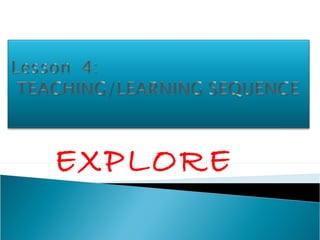
Lesson 4, explore
- 1. EXPLORE
- 2. At this stage, the teacher should be able to do the following: ◦ Use non-formative assessment procedures to diagnose /check / evaluate the learners’ readiness and competence on the prerequisite knowledge and skills to the tasks at hand. ◦ Introduce the essential questions, “How does the interplay of the elements of short story create a meaningful whole?” and “What is a personal narrative without human experience?” ◦ Invite the learners to answer the essential questions and share what they know about the elements of short story that can bring out its meaning. ◦ Make learners aware of the desired results that is, for him / her to demonstrate understanding of the close relationships among the elements of a short story that bring out its meaning. ◦ Inform the learners of their output i.e. an insightful personal narrative based on the criteria for assessment.
- 4. REVIEW REPORT for ELEMENTS of SHORT STORY Group Number: ___________________________ Section: __________________
- 5. SUPERIO -The content is superior in meeting the R requirements of the task. -The speaker provides a variety of 10 types of content appropriate for the task , details, and various forms of evidence. -The speaker adapts the content in a specific way to the listener and situation. -The speaker takes into account the specific knowledge and experience of
- 6. meet the requirements of the task. 9 -The speaker focuses primarily on relevant content. -The speaker adapts the content in a general way to the listener and situation. -The speaker uses words and concepts which are appropriate for the MINIMAL - The speaker does not provide enough knowledge content to meet the requirements of and experience of a general audience. 8 the -The speaker uses words which are task. familiar to the audience. -The speaker includes some irrelevant content, wanders off the topic. -The speaker adapts poorly to the listener and the situation, uses words and
- 7. Guess the possible title of the narrative which will be mimed through a short video clip.
- 8. EVITARRAN
- 9. LUFTHGISNI
- 10. LANOSREP
- 11. Do you know what are we about to learn?
- 13. Read the biblical myth “Lazarus and the Rich Man. (Bring Bible if possible).
